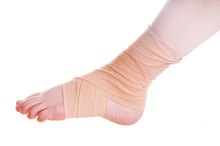What Causes Edema in One Ankle?
Edema means swelling of the soft tissues. It tends to occur in the feet, ankles and legs or the back in persons who are lying flat for long periods of time. It also most frequently occurs in both legs. The presence of edema in both legs has a broad number of possible causes 1. The presence of edema in one ankle narrows the diagnostic possibilities quite a bit 1.
If you are experiencing serious medical symptoms, seek emergency treatment immediately.
Venous Obstruction
Obstruction of veins draining the leg on one side of the body can cause edema in one leg. A blood clot in the leg, known as a DVT for deep vein thrombosis, is one possible cause of venous obstruction. A DVT is more common when a person is inactive for extended periods, such as during a long flight. Veins can also be obstructed by baker's cyst, also called a popliteal cyst. This is a fluid filled growth at the back of the knee joint. If large enough, it can interfere with the flow of blood out of the leg, leading to edema. Benign or cancerous tumors can also obstruct veins as can scar tissue.
- Obstruction of veins draining the leg on one side of the body can cause edema in one leg.
- If large enough, it can interfere with the flow of blood out of the leg, leading to edema.
Venous Insufficiency
What Are the Causes of Unilateral Upper Limb Edema?
Learn More
Whereas venous obstruction refers to something extrinsic impeding the flow of blood back towards the heart through veins, venous insufficiency refers to an intrinsic problem with the veins. Varicose veins are a cause of venous insufficiency. These are enlarged veins with poorly working valves. Normal veins have one-way valves, the valves of varicose veins allow blood to flow backwards. This condition is associated with increasing age and pregnancy.
- Whereas venous obstruction refers to something extrinsic impeding the flow of blood back towards the heart through veins, venous insufficiency refers to an intrinsic problem with the veins.
- Normal veins have one-way valves, the valves of varicose veins allow blood to flow backwards.
Lymphatic Obstruction
The lymphatic system drains the fluids in tissues back into the venous system. If the lymphatic system is damaged or obstructed in one leg, the fluid cannot drain from the leg, leading to edema. Lymphatics can be obstructed by tumors, infections or removal of the lymph nodes during surgery.
Infection or Trauma
What Are the Causes of Water Retention in Men?
Learn More
Local infections or trauma near the ankle can cause edema. Cellulitis is an infection of the soft tissues. When infected, the immune system and blood vessels in the area react to fight off the infection. The small blood vessels become leaky, allowing more fluid and immune cells out into the tissues. The area becomes hot and swollen from the vascular reponse. Trauma can initiate a similar response. Instead of bacteria as in cellulitis, the tissue damage from trauma initiates the inflammatory response.
- Local infections or trauma near the ankle can cause edema.
- The small blood vessels become leaky, allowing more fluid and immune cells out into the tissues.
Reflex Sympathetic Dystrophy
Reflex sympathetic dystrophy is caused by damage to specialized nerves called sympathetic nerves. It is rare and generally develops after trauma or surgery to the affected area. The nerves and blood vessels of the affected area do not work properly. It causes extreme burning pain, temperature and color changes and swelling of the area.
- Reflex sympathetic dystrophy is caused by damage to specialized nerves called sympathetic nerves.
- The nerves and blood vessels of the affected area do not work properly.
May-Thurner Syndrome
May-Thurner syndrome is a result of the anatomy of the blood vessels in the pelvis near the legs. In this syndrome, the left iliac vein is compressed by the right iliac artery. This leads to development of a blood clot in the left leg, a deep vein thrombosis, causing edema 2.
Related Articles
References
- "Harrison's Principles of Internal Medicine"; Anthony Fauci; 17th Ed 2008
- "Robbins & Cotran Pathologic Basis of Disease" Vinay Kumar; 8th Ed 2009
- Boisseau, M. (2018). Chronic venous disease and the genetic influence - Servier - Phlebolymphology.
- Chaer, R. (2017). Vascular Disease in Older Adults. Cham: Springer, p.98.
- Cleveland Clinic. 2018. Chronic Venous Insufficiency (CVI) Treatment Options.
- Goldstein, E. and Weingarten, M. (2001). State-of-the-Art Treatment of Chronic Venous Disease. Clinical Infectious Diseases, 32(6), pp.949-954. DOI: 10.1086/319360.
- Vascularcures.org. (2018). Chronic Venous Insufficiency.
Writer Bio
Dr. Matthew Fox graduated from the University of California with a Bachelor of Arts in molecular, cell and developmental biology and received a M.D. from the University of Virginia. He is a pathologist and has experience in internal medicine and cancer research.









